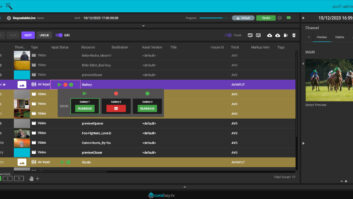The broadcast sector is engaged in tough competition to remain engaged with consumers as new entrants in the market challenge traditional their once-dominant position. The rapid evolution of video content capture and delivery technologies is consequently prompting broadcasters to improve their competitive position in an increasingly complex market, according to Bruno Teissier senior vice president of sales, VITEC, a leading provider of IPTV and video streaming solutions for the broadcast sector.
“Internet protocol (IP) video will play a critical role in optimising workflows to keep opex down,” says Tessier. “Beyond cost efficiencies, new workflows will also lead broadcasters to develop new offerings that better position them to compete with new media providers.”
A market in transition
Demand for live and on-demand video content feeds has increased significantly with new video capture and broadcast technologies. These new technologies have opened the door to new players – especially streaming service providers – striving to meet consumer demand for video offerings. This is challenging broadcasters to deliver new enhanced services while holding the line on operational costs.
“As broadcast production teams across the industry act to meet the evolving demands of the different markets they serve, meeting these challenges will not be easy. Each geography comes with its own needs, objectives and limitations when managing everything from network latency and content quality to optimising financial performance,” said Teissier.
Leaders in the sector must consequently focus on moving forward with existing and new value propositions while reducing opex and maintaining sustainability; now an important priority for a growing number of broadcasters. All providers must figure out how to work within the parameters of constrained networks.
Meanwhile, a tremendous amount of content is being produced by nearly every broadcast category. Companies like ESPN, Bally Sports and TV2 Norway are covering more international, national and local sports events than ever to meet both the mass market and niche demands of their audiences.
“Executives at these companies increasingly realise that if broadcasters fail to address these demands, other players will. New robust competition is emerging from other video-centric platforms – like Instagram and TikTok – offering consumers more sources of video distribution and formats than ever before,” he added.
Broadcasters, said Teissier, must respond by reviewing current operations, addressing emerging demand and investing in new processes and technologies that allow them to cost-effectively compete in this environment.
“Almost every aspect of broadcast operations has become more complicated. More equipment and technology are needed to capture, process and distribute content. Audiences have also become more fragmented, creating demands for new formats – including long-form and short-form content – that can be displayed on TVs, mobile phones, computer screens and tablets. Today, game consoles and social platforms are important engagement vectors for those targeting younger audiences,” continued Teissier.
Rising complexity typically comes with elevated costs. Few broadcasters can afford to absorb more expenses. This means leaders in the industry need technologies that can manage complexity while meeting the diverse needs of their markets without a commensurate increase in employee headcount or operational expenditures.
“That is why adoption of new intelligent, automated, energy-efficient and sustainable technologies will be critical for the broadcasting industry. As broadcasters modernise and refresh their technology investments, they must not only focus on optimising operating costs but also on improving technical performance by reducing latency across the delivery pipeline.”
Intelligent IP-based solutions define the future of broadcasters
Solutions that deliver video over internet protocols while taking into account the requirements of the broadcast domain – including video format, codec standards, and streaming protocols – will play an important role in ensuring quality, operational performance and economic efficiency.
“VITEC has developed tools and solutions that can be used by reporters in the field to send their news feeds to the mixing and editing facilities at studios in an efficient manner. We are streamlining costs through automation and integration while creating the flexibility for broadcast operations managers to tailor specific services for specific audiences. The foundation is thus established for harvesting long-tail opportunities in a profitable manner,” explained Teissier.
The company has fielded teams to establish innovative connections between artificial intelligence (AI) and interesting IP video applications that address the growing automation and integration requirements of the industry.
“We are embedding intelligence into our broadcast products to provide production teams with intuitive tools for creating compelling features without the need for additional human resources and redundant technical investments. For example, with unmanaged networks like the public internet, broadcast managers can adapt bit rate on the fly features in VITEC products to enable the best video quality regardless of the bandwidth available.”
VITEC’s mission for the past 35 years has been to harness next-generation technologies that are robust, intelligent, and interoperable with other critical elements of broadcast operations.
“As we move forward, VITEC is committed to enabling higher levels of agility, while introducing opportunities to enhance sustainability practices across the industry,” concluded Teissier.







